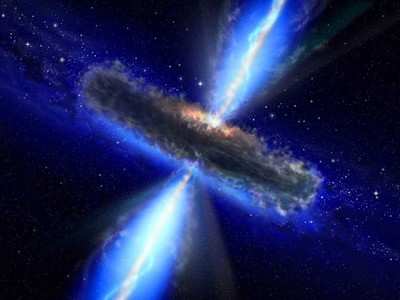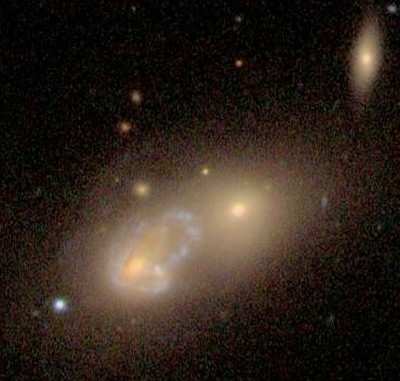NASA Swift Reveals Range Of Distinctive Traits
An ongoing X-ray survey undertaken by NASA's Swift spacecraft is
revealing differences between nearby active galaxies and those
located about halfway across the universe. Understanding these
differences will help clarify the relationship between a galaxy and
its central black hole.

"There's a lot we don't know about the workings of supermassive
black holes," says Richard Mushotzky of NASA's Goddard Space Flight
Center in Greenbelt, MD. Astronomers think the intense emission
from the centers, or nuclei, of active galaxies arises near a
central black hole containing more than a million times the sun's
mass. "Some of these feeding black holes are the most luminous
objects in the universe. Yet we don't know why the massive black
hole in our own galaxy and similar objects are so dim."
NASA's Swift spacecraft is designed to hunt gamma-ray bursts.
But in the time between these almost-daily cosmic explosions,
Swift's Burst Alert Telescope (BAT) scans the sky. The survey is
now the largest and most sensitive census of the high-energy X-ray
sky.
Mushotzky presented a progress report Tuesday on the BAT Hard
X-ray Survey at the American Astronomical Society meeting in Long
Beach, CA. "The BAT sees about half of the entire sky every day,"
he says. "Now we have cumulative exposures for most of the sky that
exceed 10 weeks."

Galaxies that are actively forming stars have a distinctly
bluish color ("blue and booming"), while those not doing so appear
quite red. Nearly a decade ago, surveys with NASA's Chandra X-Ray
Observatory and ESA's XMM-Newton showed that active galaxies some 7
billion light-years away were mostly massive "red and dead"
galaxies in normal environments.
The BAT survey looks much closer to home, within about 600
million light-years. There, the colors of active galaxies fall
midway between blue and red. Most are spiral and irregular galaxies
of normal mass, and more than 30 percent are colliding. "This is
roughly in line with theories that mergers shake up a galaxy and
'feed the beast' by allowing fresh gas to fall toward the black
hole," Mushotzky says.

Until the BAT survey, astronomers could never be sure they were
seeing most of the active galactic nuclei. An active galaxy's core
is often obscured by thick clouds of dust and gas that block
ultraviolet, optical and low-energy ("soft") X-ray light. Dust near
the central black hole may be visible in the infrared, but so are
the galaxy's star-formation regions. And seeing the black hole's
radiation through dust it has heated gives us a view that is one
step removed from the central engine. "We're often looking through
a lot of junk," Mushotzky says.
But "hard" X-rays -- those with energies between 14,000 and
195,000 electron volts -- can penetrate the galactic gunk and allow
a clear view. Dental X-rays work in this energy range.
Unlike most telescopes, the Swift's BAT contains no optics to
focus incoming radiation. Instead, images are made by analyzing the
shadows cast by 52,000 randomly placed lead tiles on 32,000 hard
X-ray detectors.

Astronomers think that all big galaxies have a massive central
black hole, but less than 10 percent of these are active today.
Active galaxies are thought to be responsible for about 20 percent
of all energy radiated over the life of the universe, and are
thought to have had a strong influence on the way structure evolved
in the cosmos.
Swift, launched in November 2004, is managed by NASA Goddard. It
was built and is being operated in collaboration with Penn State,
the Los Alamos National Laboratory, and General Dynamics in the US;
the University of Leicester and Mullard Space Sciences Laboratory
in the United Kingdom; Brera Observatory and the Italian Space
Agency in Italy; plus additional partners in Germany and Japan.
 ANN's Daily Aero-Linx (04.16.24)
ANN's Daily Aero-Linx (04.16.24) Aero-News: Quote of the Day (04.16.24)
Aero-News: Quote of the Day (04.16.24) Airborne 04.10.24: SnF24!, A50 Heritage Reveal, HeliCycle!, Montaer MC-01
Airborne 04.10.24: SnF24!, A50 Heritage Reveal, HeliCycle!, Montaer MC-01 Airborne 04.12.24: SnF24!, G100UL Is Here, Holy Micro, Plane Tags
Airborne 04.12.24: SnF24!, G100UL Is Here, Holy Micro, Plane Tags Airborne-Flight Training 04.17.24: Feds Need Controllers, Spirit Delay, Redbird
Airborne-Flight Training 04.17.24: Feds Need Controllers, Spirit Delay, Redbird






